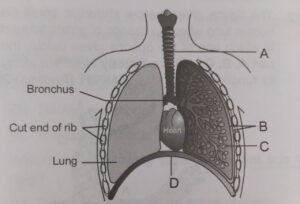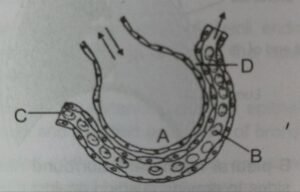Here are very important previous year NEET questions from chapter Breathing and exchange of gases. Attempt these breathing and exchange of gases NEET questions to check your preparation. Also comment how many of them you got right. All the best!
1. The partial pressure of oxygen in the alveoli of the lungs is [NEET(Phase-2) 2016]
(1) Equal to that in the blood
(2) More than that in the blood
(3) Less than that in the blood
(4) Less than that of carbon dioxide
2. Lungs do not collapse between breaths and some air always remains in the lungs which can never be expelled because [NEET(Phase-2) 2016]
(1) There is a negative pressure in the lungs
(2) There is a negative intrapleural pressure pulling at the lung walls.
(3) There is a positive intrapleural pressure.
(4) Pressure in the lungs is higher than the atmospheric pressure.
3. Name the chronic respiratory disorder caused mainly by cigarette smoking [NEET-2016]
(1) Respiratory alkalosis
(2) Emphysema
(3) Asthma
(4) Respiratory acidosis
4. Reduction in pH of blood will (NEET-2016)
(1) Release bicarbonate ions by the liver
(2) Reduce the rate of heart beat
(3) Reduce the blood supply to the brain
(4) Decrease the affinity of hemoglobin with oxygen
5. Asthma may be attributed to [NEET-2016]
(1) Accumulation of fluid in the lungs
(2) Bacterial infection of the lungs
(3) Allergic reaction of the mast cells in the lungs
(4) Inflammation of the trachea
6. When you hold your breath, which of the following gas changes in blood would first lead to the urge to breathe? [AIPMT-2015]
(1) Rising CO₂ and falling O2 concentration
(2) Falling O₂ concentration
(3) Rising CO₂ concentration
(4) Falling CO₂ concentration
7. Approximately seventy percent of carbon-dioxide absorbed by the blood will be transported to the lungs [AIPMT-2014]
(1) As bicarbonate ions
(2) In the form of dissolved gas molecules
(3) By binding to R.B.C.
(4) As carbamino- haemoglobin
8. The figure shows a diagrammatic view of human respiratory system with labels A, B, C and D. Select the option which gives correct identification and main function and/or characteristic. (NEET-2013)

(1) B-pleural membrane-surround ribs on both sides to provide cushion against rubbing
(2) C-Alveoli-thin walled vascular bag like structures for exchange of gases
(3) D-lower end of lungs-diaphragm pulls it down during inspiration
(4) A-trachea-long tube supported by complete cartilaginous rings for conducting inspired air
9. Which one of the following is the correct statement for respiration in humans? [AIPMT (Prelims)-2012]
(1) About 90% of carbon dioxide (CO₂) is carried by haemoglobin as carbamino-haemoglobin
(2) Cigarette smoking may lead to inflammation of bronchi
(3) Neural signals from pneumotaxic centre in pons region of brain can increase the duration
of inspiration
(4) Workers in grinding and stone-breaking industries may suffer, from lung fibrosis
10. People who have migrated from the planes to an area adjoining Rohtang Pass about six months back
[AIPMT (Prelims)-2012]
(1) Have the usual RBC count but their haemoglobin has very high binding affinity to O₂,
(2) Have more RBCs and their haemoglobin has a lower binding affinity of O₂
(3) Are not physically fit to play games like football
(4) Suffer from altitude sickness with symptoms like nausea, fatigue, etc
11. A large proportion of oxygen is left unused in the human blood even after its uptake by the body tissues. This O₂ [AIPMT (Prelims)-2011]
(1) Helps in releasing more O₂, to the epithelial tissues
(2) Acts as a reserve during muscular exercise
(3) Raises the pCo₂ of blood to 75 mm of Hg.
(4) Is enough to keep oxyhaemoglobin saturation at 96%
12. The figure given below shows a small part of human lung where exchange of gases take place . In which one of the options given below, the one part A, B, C, or D is correctly identified along with its function .[AIPMT (Prelims)-2011]

(1) B: Red blood cell-transport of CO₂, mainly.
(2) C: Arterial capillary-passes oxygen to tissues
(3) A: Alveolar cavity- main site of exchange of respiratory gases
(4) D: Capillary wall – exchange of O₂, and CO₂ takes place here.
13. Bulk of carbon dioxide (CO₂) released from body tissues into the blood is present as [AIPMT (Mains)-2011]
(1) 70% carbamino-haemoglobin and 30% as bicarbonate
(2) Carbamino-haemoglobin in RBCs
(3) Bicarbonate in blood plasma and RBCs
(4) Free CO₂, in blood plasma
14. Which one of the following is a possibility for most of us in regard to breathing , by making a conscious effort? [AIPMT (Mains)-2011]
(1) One can consciously breathe in and breathe out by moving the diaphragm alone, without moving the ribs at all
(2) The lungs can be made fully empty by forcefully breathing out all air from them
(3) One can breathe out air totally without oxygen
(4) One can breathe out air through eustachian tubes by closing both the nose and the mouth
15. Which two of the following changes (a-d) usually tend to occur in the plain dwellers when they move to high altitudes (3,500 m or more)? [AIPMT (Prelims)-2010)
(a) Increase in red blood cell size
(b) Increase in red blood cell production
(c) Increased breathing rate
(d) Increase in thrombocyte count
Changes occurring are
1. (a) & (b)
2. (b) &(c)
3. (c)& (d)
4. (a) & (d)
16. Listed below are four respiratory capacities (a-d) and four jumbled respiratory volumes of a normal human adult: Respiratory capacities and volumes
(a) Residual volume 2500 mL
(b) Vital capacity 3500 mL
(c) Inspiratory reserve volume 1200 mL
(d) Inspiratory capacity 4500 mL
Which one of the following is the correct matching of two capacities and volumes [AIPMT (Prelims)-2010)]
(1) (a) 4500 mL. (b) 3500 mL
(2) (b) 2500 mL. (c) 4500 ml
(3) (c) 1200 mL. (d) 2500 mL
(4) (d) 3500 mL. (a) 1200 mL
17. What is vital capacity of our lungs? [AIPMT (Mains)-2011]
(1) Total lungs capacity minus residual volume
(2) Inspiratory reserve volume plus tidal volume
(3) Total lungs capacity minus expiratory reserve volume
(4) Inspiratory reserve volume plus expiratory reserve volume
18. Increased asthamatic attacks in certain seasons are related to [AIPMT (Prelims)-2007]
(1) Low temperature
(2) Hot and humid environment
(3) Eating fruits preserved in tin containers
(4) Inhalation of seasonal pollen
19. People living at sea level have around 5 million RBC per cubic millimeter of their blood whereas those living at an altitude of 5400 metres have around 8 million. This is because at high altitude
[AIPMT (Prelims)-2006]
(1) People get pollution-free air to breathe and more oxygen is available
(2) Atmospheric O₂ level is less and hence more RBCs are needed to absorb the required amount of O₂, to survive
(3) There is more UV radiation which enhances RBC production
(4) People eat more nutritive food, therefore more RBCs are formed
(20) Which one of the following statements is incorrect? [AIPMT (Prelims)-2006]
(1) The residual air in lungs slightly decreases the efficiency of respiration in mammals
(2) The presence of non-respiratory air sacs, increases the efficiency of respiration in birds
(3) In insects, circulating body fluids serve to distribute oxygen to tissues
(4) The principle of countercurrent flow facilitates efficient respiration in gills of fishes
(21) The majority of carbon dioxide produced by our body cells is transported to the lungs
[AIPMT (Prelims)-2006]
(1) Dissolved in the blood
(2) As bicarbonates
(3) As carbonates
(4) Attached to haemoglobin
Solve NCERT based MCQs on breathing and exchange of gases: Click here
Total 21 breathing and exchange of gases neet questions are listed here. More will be added soon. Please comment about your score.
